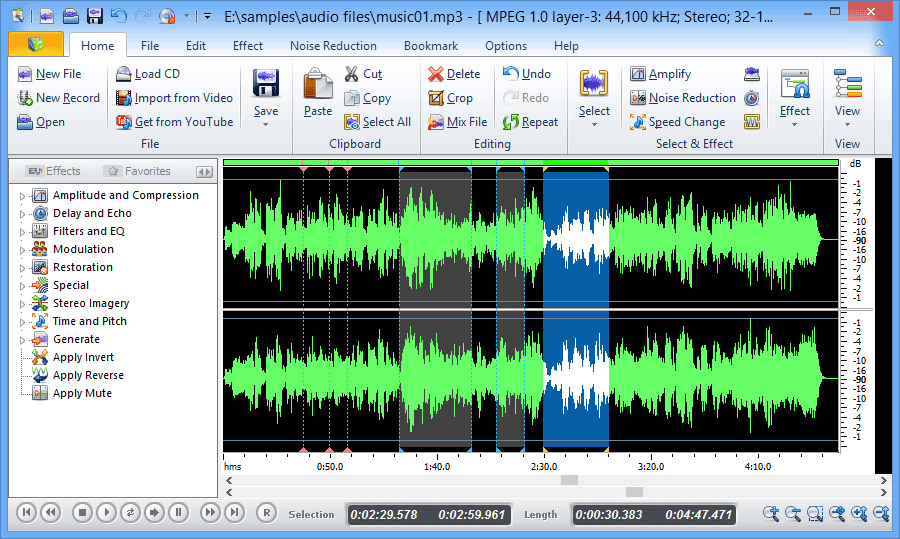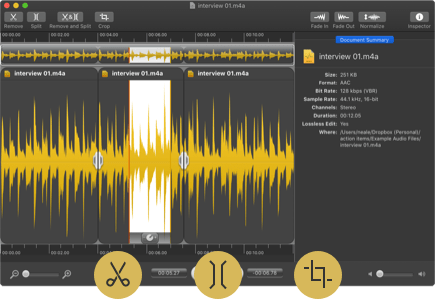


- #FREE AUDIO EDITOR THAT USES WAV FILES MAC OS#
- #FREE AUDIO EDITOR THAT USES WAV FILES FULL#
- #FREE AUDIO EDITOR THAT USES WAV FILES LICENSE#
- #FREE AUDIO EDITOR THAT USES WAV FILES DOWNLOAD#
- #FREE AUDIO EDITOR THAT USES WAV FILES FREE#
Once you created a new project you set set the project sampling rate to 8kHz. In Audacity, you first start by creating a new project ( File>New). You can use Audacity to record prompts directly. I have used Audacity to record prompts, edit prompts, and convert prompts for both methods.įor this blog, I will focus using Audacity for recording prompts using and for editing pre-recorded content for use with Cisco UCCX. The second method is to record the prompts off line and upload them. One method is to use a custom CRS script to create prompts using the telephone user interface (TUI). There are essentially two methods one can use to create UCCX prompts. WAV files that have the following attributes: Screen shots and procedures are based on Audacity version 1.3. The 1.3 beta has crashed on me once or twice but the interface has a number of enhancements that definitely make it worthwhile (and it does recover gracefully, for whatever that is worth).

I also have Audacity 1.2.6 on my Windows VM.
#FREE AUDIO EDITOR THAT USES WAV FILES MAC OS#
I currently use Audacity 1.3 beta on Mac OS X. The latest release is available on sourceforge ( Audacity Download).
#FREE AUDIO EDITOR THAT USES WAV FILES FREE#
Audacity has a pretty robust set of features for a free application. It runs on Windows, Mac OS X, and GNU/Linux platforms. Audacity is a free audio editor and recorder that has been around since 2000. WAV file into MP3 format while maintaining the integrity of the loop. WAV file directly into Flash, and place the sound file on a layer. If you use Flash, the process is very easy. WAV loops can also be easily processed with Flash for web animations.
#FREE AUDIO EDITOR THAT USES WAV FILES FULL#
Loops can be used to extend a full track or just by itself. WAV files are lossless uncompressed broadcast CD quality music files. Worse, even if two tracks are decompressed and merged into a single track, a gap will usually remain between them. This delay may also vary from encoder to encoder. In short, you don’t get a seamless loop.Īlso called the encoder delay, this gap occurs because the MP3 standard does not define a way to record the amount of delay or padding for later removal. So if you try to loop the audio, you can hear a short pause – a “hiccup” – at the looping point. This is because the MP3 compression algorithm leaves a silent space of 10ms to 50ms at the start and end of the file. There is always a small silent gap at the beginning and the end of the file. However, one of the big drawback of MP3 files is that they are just not good for looping. This is why MP3 files are the natural choice when people want music for websites or multimedia presentations. At the same time, they are able to deliver audio that is almost CD quality. As a result, they take up very little disk space and are quick to download. They are incredibly popular with users because the audio files are compressed to about one tenth of the original size. MP3 files are the sound part of an MPEG file. To ensure that the music plays seamlessly without a pause, the beginning and end of the file is carefully edited to ensure that we don’t ‘hear’ the point where the music ends and begins. WAV format and not MP3 format because the MP3 format is not good for creating seamless loops.Ī loop is a small audio file, usually 8-30 seconds long that is played over and over again for the duration of your choice or until the viewer does an action like a click to move on to the next section. The short answer is simple: loops are always delivered in. If you are looking for audio loops for your project or for Flash animations, you will notice that our loops are always delivered in the. If your project requires a different level of compression you can easily do it yourself with iTunes using the.

#FREE AUDIO EDITOR THAT USES WAV FILES DOWNLOAD#
There are several levels of possible compression but for Internet usage we recommend 128kbps which is what you download automatically from our server when you order music from us. It loads rapidly and still plays with a very good sound quality. Use MP3 files for web pages, web videos, in fact for anything on the Internet. WAV files are also the right choice for loops to be processed with Flash for web animations. WAV files are lossless, uncompressed, broadcast CD quality music files. WAV files for TV, radio, DVD or any other media requiring top uncompromised audio quality. Except in the case of music loops, which we offer for download only in the. WAV and the MP3 versions of the music track.
#FREE AUDIO EDITOR THAT USES WAV FILES LICENSE#
Whenever you license music from, you can download both the.


 0 kommentar(er)
0 kommentar(er)
